light TOYOTA RAV4 2019 Owners Manual (in English)
[x] Cancel search | Manufacturer: TOYOTA, Model Year: 2019, Model line: RAV4, Model: TOYOTA RAV4 2019Pages: 728, PDF Size: 21.09 MB
Page 650 of 728

6508-2. Steps to take in an emergency
Negative (-) battery term inal (second vehicle)
Solid, stationary, unpainted metallic point away from the batte ry
and any moving parts as shown in the illustration
4 Start the engine of the sec-
ond vehicle. Increase the
engine speed slightly and
maintain at that level for
approximately 5 minutes to
recharge the battery of your
vehicle.
5 Vehicles with smart key sys-
tem only: Open and close
any of the doors of your vehi-
cle with the engine switch
OFF.
6 Vehicles without smart key
system: Maintain the engine
speed of the second vehicle
and start the engine of your
vehicle.
Vehicles with smart key sys-
tem: Maintain the engine
speed of the second vehicle
and start the engine of your
vehicle by turning the engine
switch to ON.
7 Once the vehicle’s engine
has started, remove the
jumper cables in the exact
reverse order from which
they were connected.
Once the engine starts, have the
vehicle inspected at your Toyota
dealer as soon as possible.
■Starting the engine when the
battery is discharged
The engine cannot be started by push-starting.
■To prevent bat
tery discharge
●Turn off the headlights and the
audio system while the engine is
stopped.
(Vehicles with Stop & Start system:
Except when the en gine is stopped
due to the Stop & Start system)
●Turn off any unnecessary electri-
cal components when the vehicle
is running at a low speed for an
extended period, such as in heavy
traffic.
■When the battery is removed or
discharged
●Information stored in the ECU is
cleared. When the battery is
depleted, have the vehicle
inspected at your Toyota dealer.
●Some systems may require initial-
ization. ( P.693)
■When removing the battery ter-
minals
When the battery terminals are
removed, the information stored in
the ECU is cleared. Before remov-
ing the battery term inals, contact
your Toyota dealer.
■Charging the battery
The electricity stored in the battery
will discharge grad ually even when
the vehicle is not in use, due to nat-
ural discharge and the draining
effects of certain electrical appli-
ances. If the vehicle is left for a long
time, the battery may discharge,
and the engine may be unable to
start. (The battery recharges auto-
matically during driving.)
■When recharging or replacing
the battery (vehicles with smart
key system)
●In some cases, it may not be pos-
C
D
Page 652 of 728
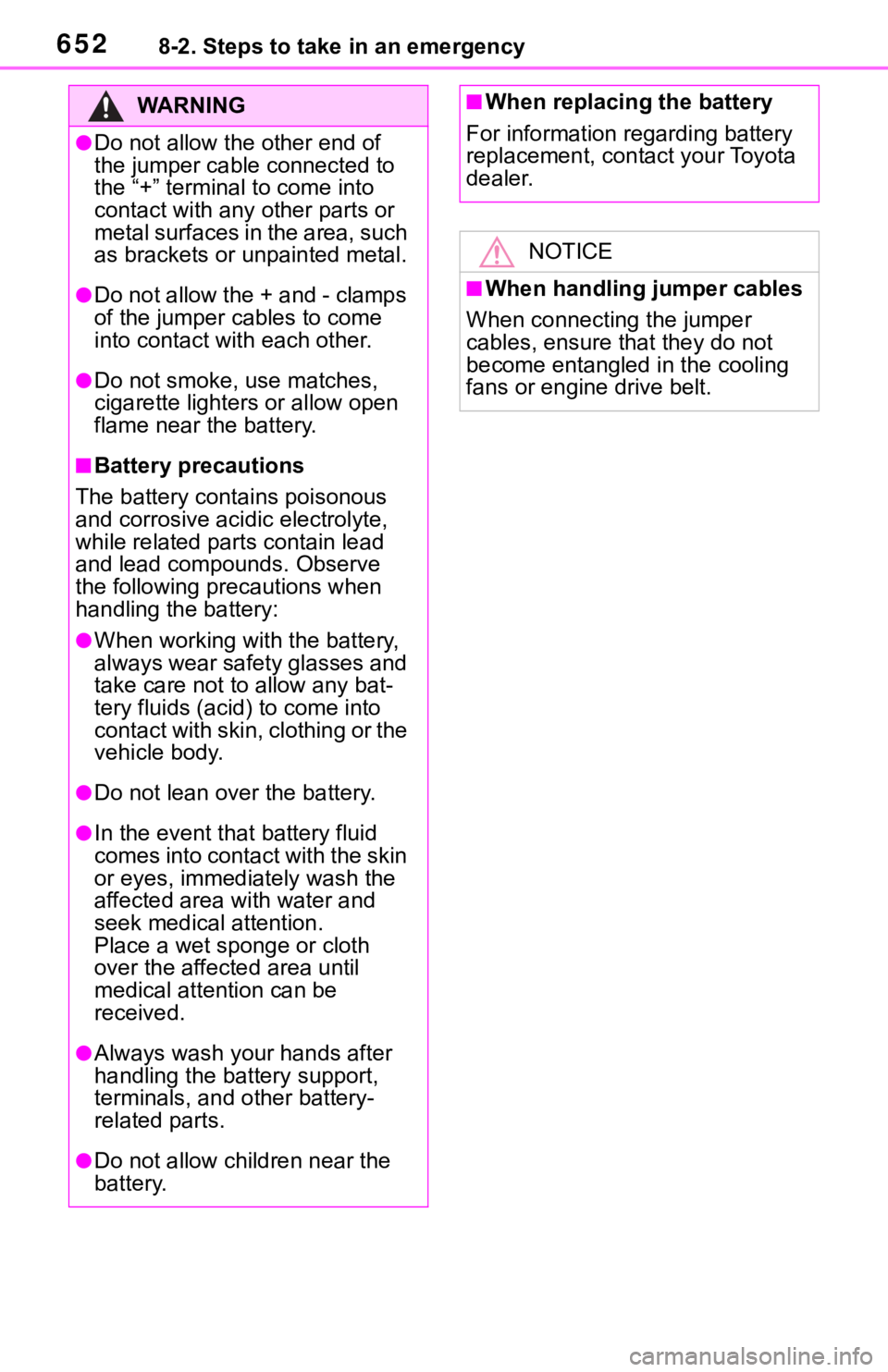
6528-2. Steps to take in an emergency
WA R N I N G
●Do not allow the other end of
the jumper cable connected to
the “+” terminal to come into
contact with any other parts or
metal surfaces in the area, such
as brackets or unpainted metal.
●Do not allow the + and - clamps
of the jumper cables to come
into contact with each other.
●Do not smoke, use matches,
cigarette lighters or allow open
flame near the battery.
■Battery precautions
The battery contains poisonous
and corrosive acid ic electrolyte,
while related parts contain lead
and lead compounds. Observe
the following precautions when
handling the battery:
●When working with the battery,
always wear safety glasses and
take care not to allow any bat-
tery fluids (acid) to come into
contact with skin, clothing or the
vehicle body.
●Do not lean over the battery.
●In the event that battery fluid
comes into contact with the skin
or eyes, immediately wash the
affected area with water and
seek medical attention.
Place a wet sponge or cloth
over the affected area until
medical attention can be
received.
●Always wash your hands after
handling the battery support,
terminals, and other battery-
related parts.
●Do not allow child ren near the
battery.
■When replacing the battery
For information regarding battery
replacement, contact your Toyota
dealer.
NOTICE
■When handling jumper cables
When connecting the jumper
cables, ensure that they do not
become entangled in the cooling
fans or engine drive belt.
Page 662 of 728

6629-1. Specifications
*: The coolant capacity is the quantity of reference.If replacement is necessary, contact your Toyota dealer.
Cooling system
Capacity*
Without engine oil
cooler7.3 qt. (6.9 L, 6.1 Imp. qt.)
With engine oil
cooler7.4 qt. (7.0 L, 6.2 Imp. qt.)
Coolant type
Use either of the following:
“Toyota Super Long Life Coolant”
Similar high-quality ethylene gly-
colbased non-silic ate, non-amine,
non-nitrite, and non-borate cool-
ant with long-life hybrid organic
acid technology
Do not use plain water alone.
Ignition system (spark plug)
MakeDENSO FC16HR-Q8
Gap0.031 in. (0.8 mm)
NOTICE
■Iridium-tipped spark plugs
Use only iridium-tipped spark plugs. Do not adjust the spark pl ug gap.
Electrical system (battery)
Specific voltage reading at
68°F (20°C):
12.3 V or higher
(Turn the engine switch to OFF and turn on
the high beam headlights for 30 seconds.)
If the voltage is lower than the standard
value, charge the battery.
Charging ratesQuick charge15 A max.
Slow charge5 A max.
Page 668 of 728

6689-1. Specifications
A: Wedge base bulbs (clear)
B: H16 halogen bulbs
C: Wedge base bulbs (amber)
D: Double end bulbs (clear)
*: If equipped
Light bulbs
Light bulbsBulb No.WTy p e
Exterior
Front side marker lightsW5W5A
Fog lights*19B
Front turn signal/parking lights
(bulb type)7444NA28/8C
Rear turn signal lightsWY21W21C
Back-up lightsW16W16A
Outer foot lights*5A
Interior
Vanity lights8A
Interior lights (front)/personal lights5A
Interior light (rear)8D
Luggage compartment light5A
Page 670 of 728
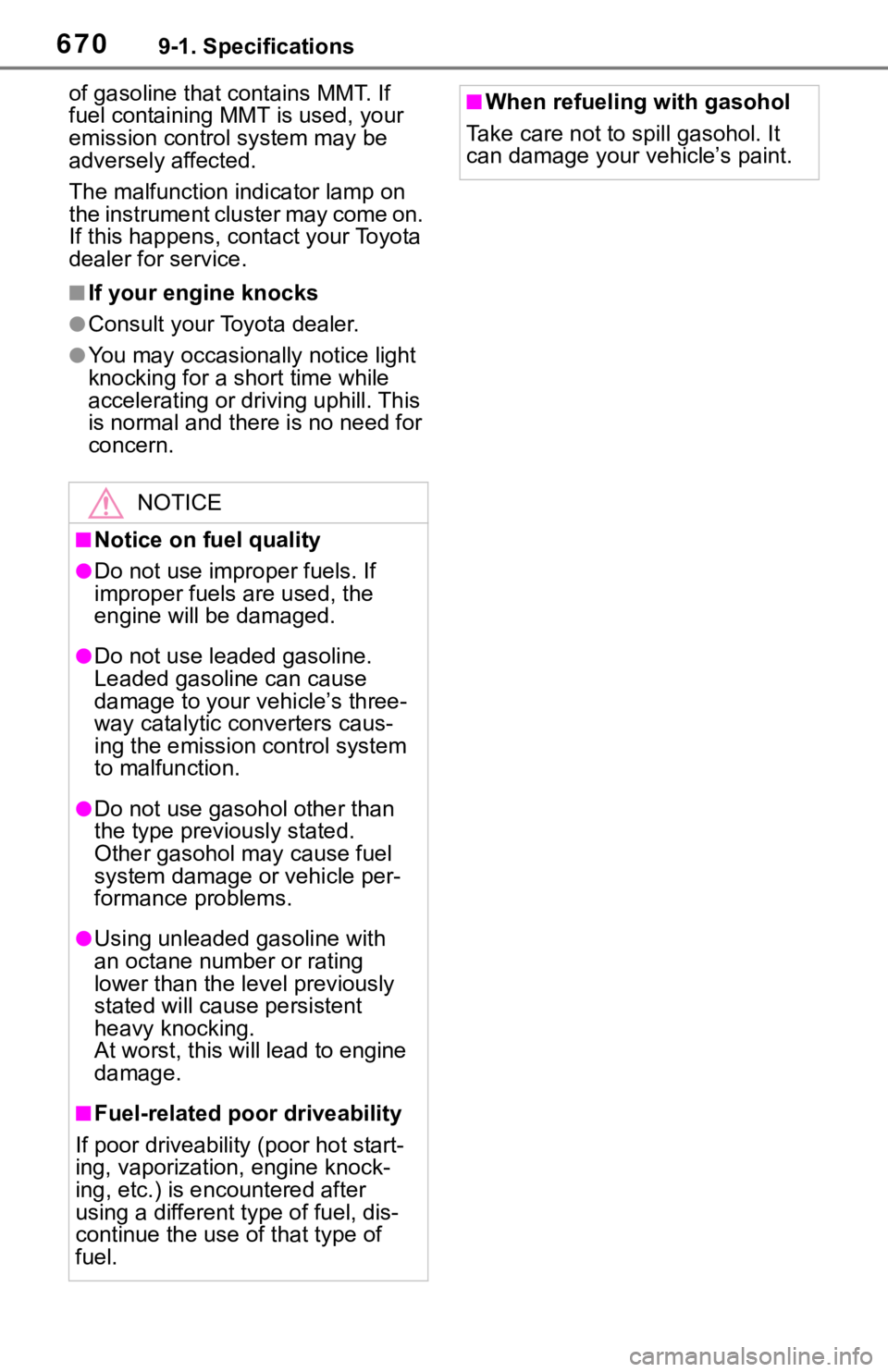
6709-1. Specifications
of gasoline that contains MMT. If
fuel containing MMT is used, your
emission control system may be
adversely affected.
The malfunction indicator lamp on
the instrument cluster may come on.
If this happens, contact your Toyota
dealer for service.
■If your engine knocks
●Consult your Toyota dealer.
●You may occasionally notice light
knocking for a short time while
accelerating or driving uphill. This
is normal and there is no need for
concern.
NOTICE
■Notice on fuel quality
●Do not use impro per fuels. If
improper fuels are used, the
engine will be damaged.
●Do not use leaded gasoline.
Leaded gasoline can cause
damage to your vehicle’s three-
way catalytic converters caus-
ing the emission control system
to malfunction.
●Do not use gasohol other than
the type previously stated.
Other gasohol may cause fuel
system damage or vehicle per-
formance problems.
●Using unleaded gasoline with
an octane number or rating
lower than the l evel previously
stated will cause persistent
heavy knocking.
At worst, this will lead to engine
damage.
■Fuel-related poor driveability
If poor driveability (poor hot start-
ing, vaporization, engine knock-
ing, etc.) is encountered after
using a different type of fuel, dis-
continue the use of that type of
fuel.
■When refueling with gasohol
Take care not to s pill gasohol. It
can damage your vehicle’s paint.
Page 678 of 728
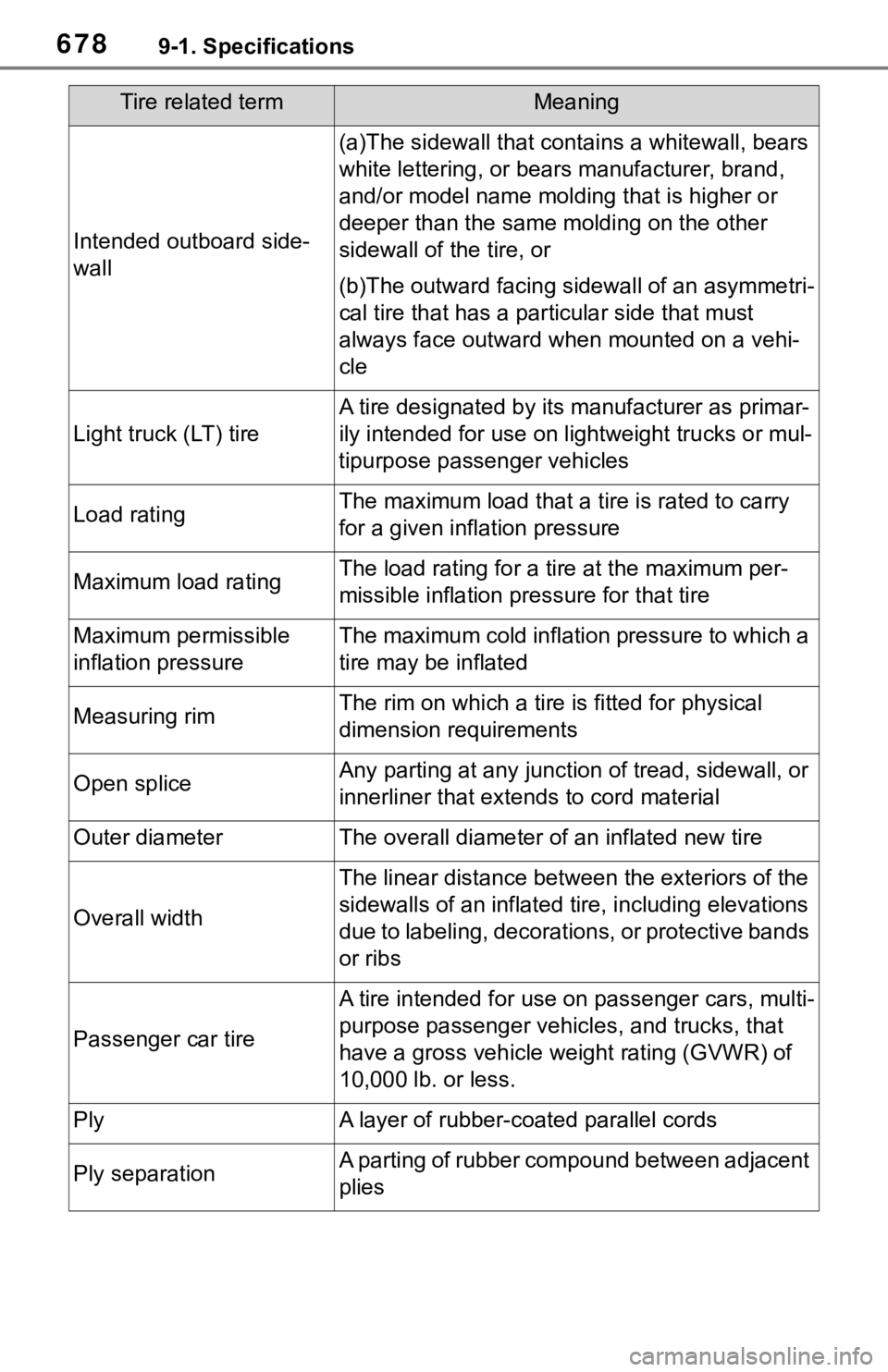
6789-1. Specifications
Intended outboard side-
wall
(a)The sidewall that contains a whitewall, bears
white lettering, or bear s manufacturer, brand,
and/or model name molding that is higher or
deeper than the same molding on the other
sidewall of the tire, or
(b)The outward facing sidewall of an asymmetri-
cal tire that has a par ticular side that must
always face outward whe n mounted on a vehi-
cle
Light truck (LT) tire
A tire designated by its manufacturer as primar-
ily intended for use on lightweight trucks or mul-
tipurpose passenger vehicles
Load ratingThe maximum load that a tire is rated to carry
for a given inflation pressure
Maximum load ratingThe load rating for a tire at the maximum per-
missible inflation pressure for that tire
Maximum permissible
inflation pressureThe maximum cold inflation pressure to which a
tire may be inflated
Measuring rimThe rim on which a tire is fitted for physical
dimension requirements
Open spliceAny parting at any junction of tread, sidewall, or
innerliner that extends to cord material
Outer diameterThe overall diameter o f an inflated new tire
Overall width
The linear distance between the exteriors of the
sidewalls of an inflated ti re, including elevations
due to labeling, decorations, or protective bands
or ribs
Passenger car tire
A tire intended for use on passenger cars, multi-
purpose passenger vehicles, and trucks, that
have a gross vehicle weight rating (GVWR) of
10,000 lb. or less.
PlyA layer of rubber-coated parallel cords
Ply separationA parting of rubber compound between adjacent
plies
Tire related termMeaning
Page 682 of 728
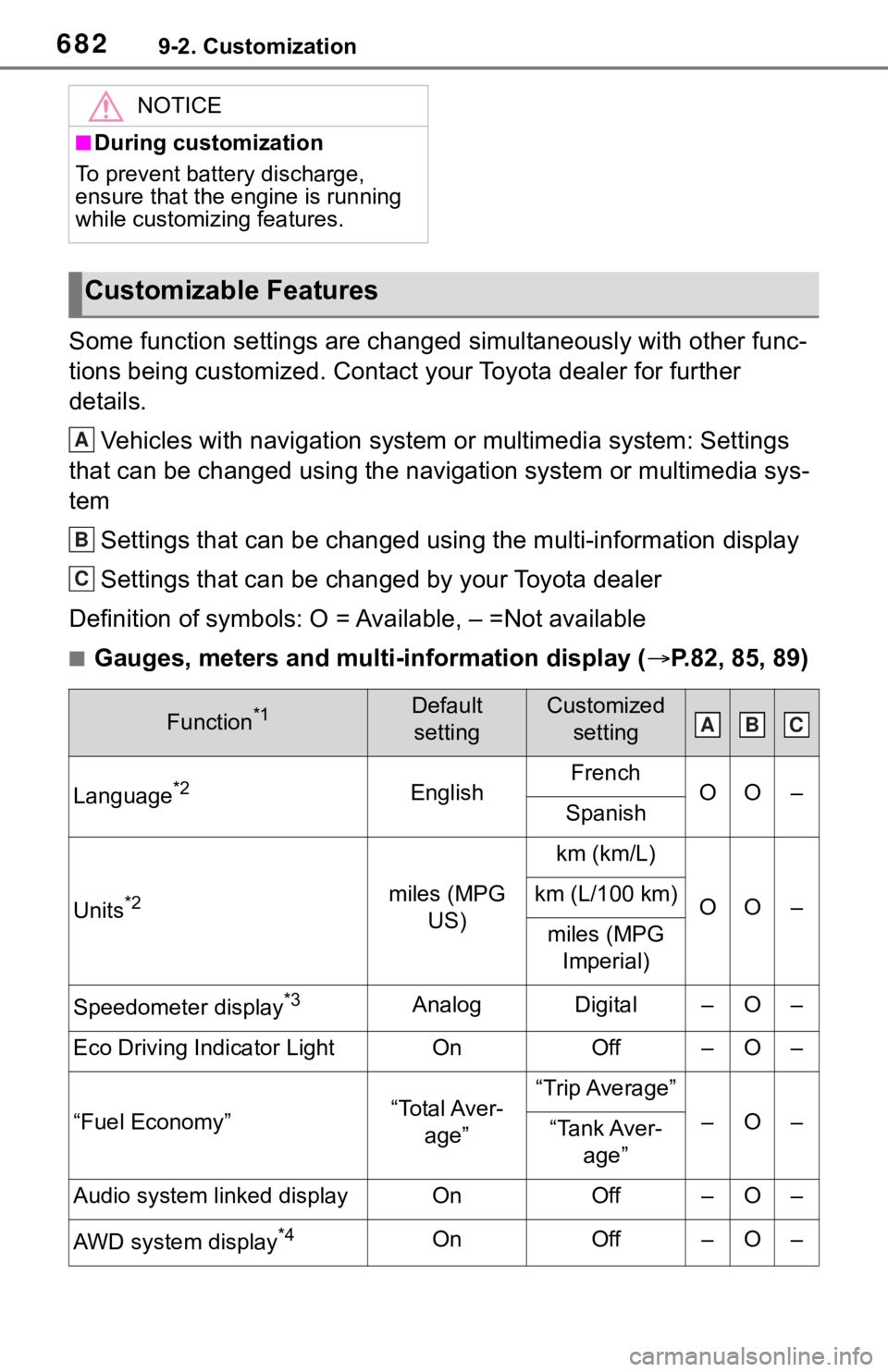
6829-2. Customization
Some function settings are changed simultaneously with other func-
tions being customized. Contact your Toyota dealer for further
details.
Vehicles with navigation system or multimedia system: Settings
that can be changed using the navigation system or multimedia s ys-
tem
Settings that can be changed using the multi-information displa y
Settings that can be changed by your Toyota dealer
Definition of symbols: O = Available, – =Not available
■Gauges, meters and multi-information display ( P.82, 85, 89)
NOTICE
■During customization
To prevent battery discharge,
ensure that the engine is running
while customizing features.
Customizable Features
Function*1Default settingCustomized setting
Language*2EnglishFrenchOO–Spanish
Units*2miles (MPG
US)
km (km/L)
OO–km (L/100 km)
miles (MPG Imperial)
Speedometer display*3AnalogDigital–O–
Eco Driving Indicator LightOnOff–O–
“Fuel Economy”“Total Aver- age”“Trip Average”
–O–“Tank Aver-age”
Audio system linked displayOnOff–O–
AWD system display*4OnOff–O–
A
B
C
ABC
Page 687 of 728
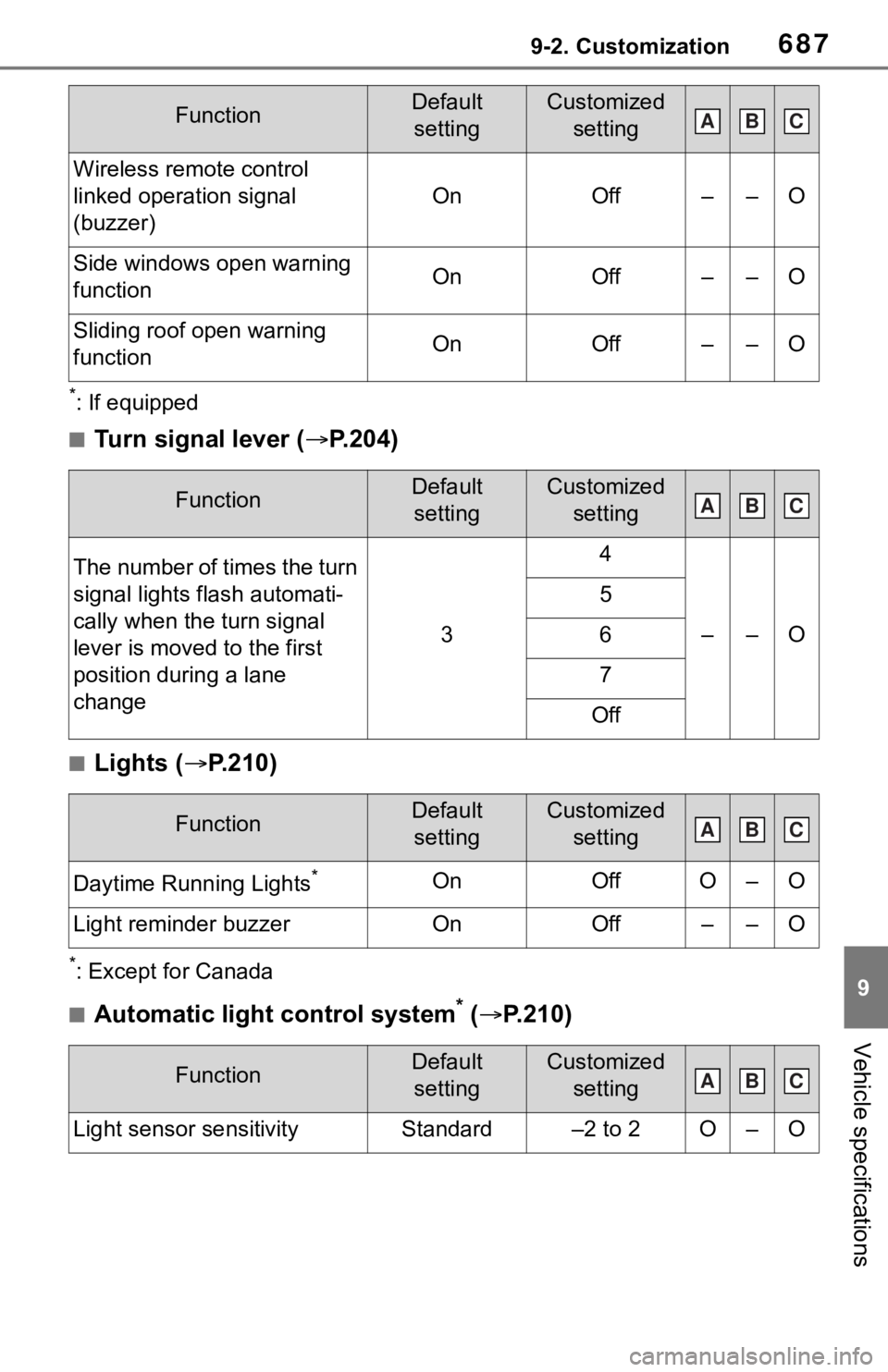
6879-2. Customization
9
Vehicle specifications
*: If equipped
■Turn signal lever (P.204)
■Lights ( P.210)
*: Except for Canada
■Automatic light control system* ( P.210)
Wireless remote control
linked operation signal
(buzzer)
OnOff––O
Side windows open warning
functionOnOff––O
Sliding roof open warning
function OnOff––O
FunctionDefault
settingCustomized setting
The number of times the turn
signal lights flash automati-
cally when the turn signal
lever is moved to the first
position during a lane
change
3
4
––O
5
6
7
Off
FunctionDefault settingCustomized setting
Daytime Running Lights*OnOffO–O
Light reminder buzzerOnOff––O
FunctionDefault settingCustomized setting
Light sensor sensitivityStandard–2 to 2O–O
FunctionDefault settingCustomized settingABC
ABC
ABC
ABC
Page 688 of 728

6889-2. Customization
*: If equipped
■Rear window wiper (P.219)
■PCS (Pre-Collision System) ( P.230)
■LTA (Lane Tracing Assist) (P.238)
Time elapsed before head-
lights automatically turn off
after doors are closed
30 seconds
Off
O–O60 seconds
90 seconds
Windshield wiper linked
headlight illuminationOnOff––O
FunctionDefault
settingCustomized setting
Back door opening linked
rear window wiper stop func-
tion
OffOn––O
Washer linked rear window
wiperOnOff––O
Shift position linked rear win-
dow wiper ( P.220)Only onceOff––OContinuous
FunctionDefault
settingCustomized setting
PCS (Pre-Collision System)OnOff–O–
Adjust alert timingMiddleFar–O–Near
FunctionDefault settingCustomized setting
Lane centering functionOffOn–O–
Steering assist functionOnOff–O–
Alert sensitivityStandardHigh–O–
Vehicle sway warning func-
tionOnOff–O–
FunctionDefault settingCustomized settingABC
ABC
ABC
ABC
Page 691 of 728
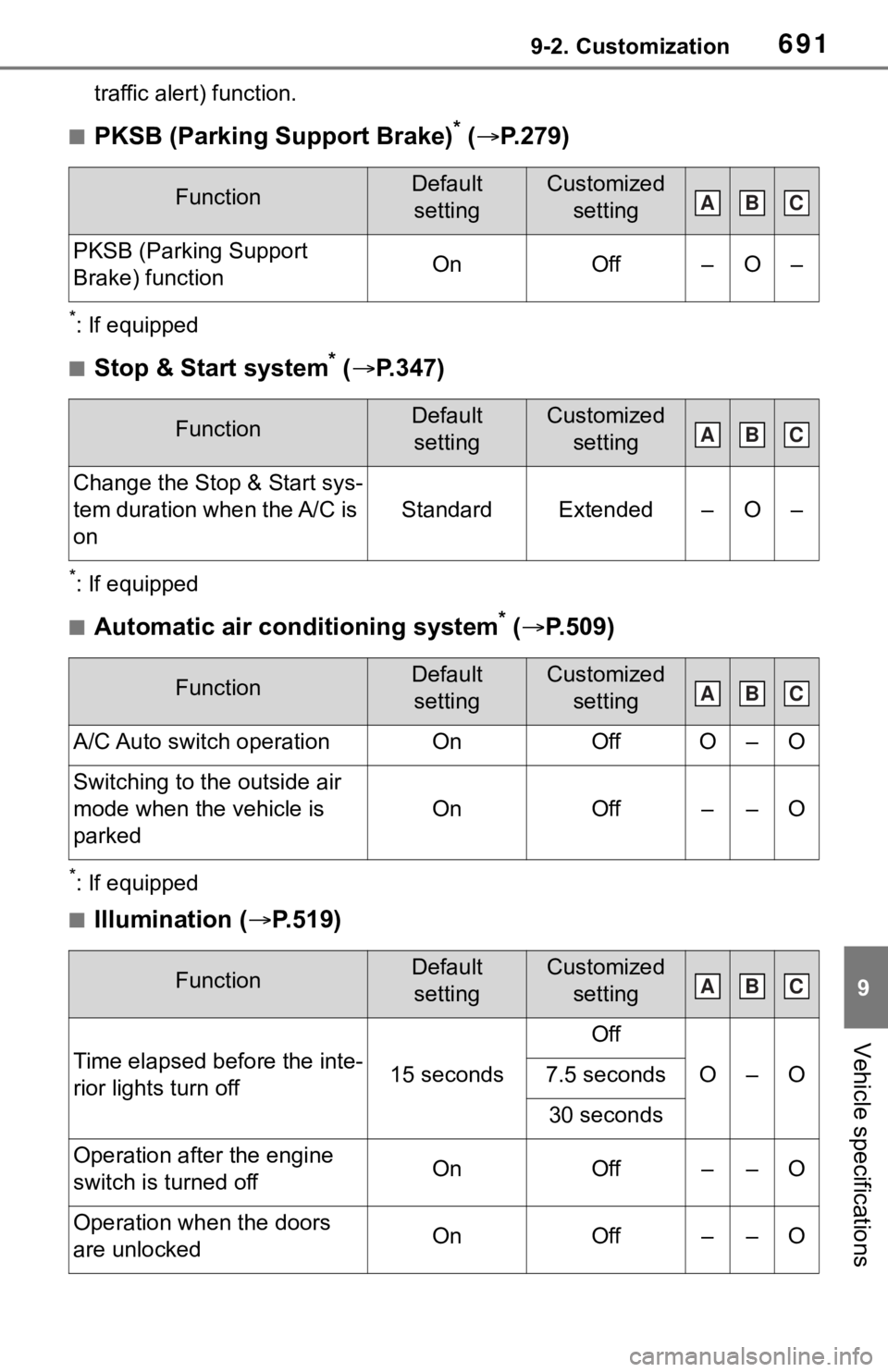
6919-2. Customization
9
Vehicle specifications
traffic alert) function.
■PKSB (Parking Support Brake)* ( P.279)
*: If equipped
■Stop & Start system* ( P.347)
*: If equipped
■Automatic air conditioning system* ( P.509)
*: If equipped
■Illumination ( P.519)
FunctionDefault
settingCustomized setting
PKSB (Parking Support
Brake) functionOnOff–O–
FunctionDefault settingCustomized setting
Change the Stop & Start sys-
tem duration when the A/C is
on
StandardExtended–O–
FunctionDefault settingCustomized setting
A/C Auto switch operationOnOffO–O
Switching to t he outside air
mode when the vehicle is
parked
OnOff––O
FunctionDefault settingCustomized setting
Time elapsed before the inte-
rior lights turn off15 seconds
Off
O–O7.5 seconds
30 seconds
Operation after the engine
switch is turned offOnOff––O
Operation when the doors
are unlockedOnOff––O
ABC
ABC
ABC
ABC